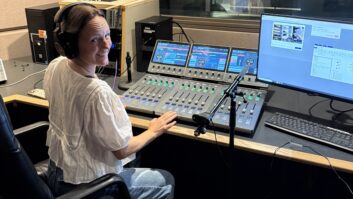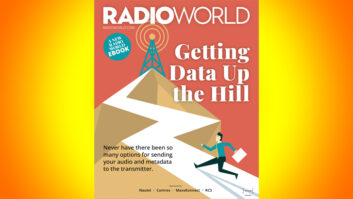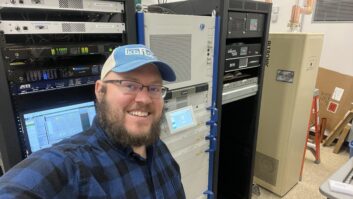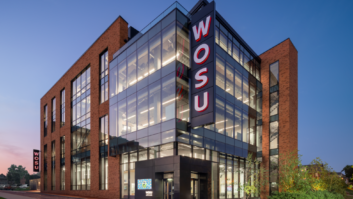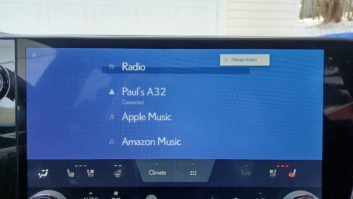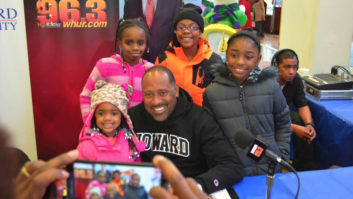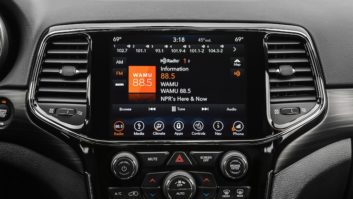More Receivers Soon, Supporters Say, With ‘Nine Automakers, 38 Models by 2008’
(click thumbnail)Beasley morning show host and Program Director Mike O’Brian, right, of KSTJ(FM) in Las Vegas, shows off the company’s HD-R demo van to NAB Radio Executive Vice President John David, center, and other attendees.
Multicasting is now the darling of HD Radio supporters, and much of the IBOC news at the spring NAB convention was about efforts of broadcasters in the HD Digital Radio Alliance to further the rollout – in part, using their additional channels.
At conventions past, industry observers asked when IBOC would arrive. Now it’s here, and we’re asking when more receivers will be available. The short answer: this summer.
Here are highlights of HD Radio news at NAB2006, with more about HD-R surround and data demos next issue.
STRUBLE: ALLIANCE HAVING ‘TREMENDOUS EFFECT’
“It’s all coming.” So says Ibiquity Digital President/CEO Robert Struble.
The efforts of the HD Digital Radio Alliance are having a tremendous effect on the digital radio rollout, the head of the technology developer believes. In an interview with Radio World, Struble pointed to recent news of additional HD2 channels coming on alliance stations and the launch or expansion of HD Radio offerings by Tweeter and Crutchfield.
“The alliance has fundamentally changed the speed at which all the players on the consumer side are acting – manufacturers, chipmakers, car guys and retailers,” said Struble. Alliance efforts “are having a major effect. We’ve never been as busy on the consumer side as we are now.”
But he sought to remind the industry that speed is relative. Focusing on the new receiver reference design that Ibiquity released to manufacturers recently to speed production of receivers, Struble said: “If we’re talking radio, where we can change a format overnight or sell an ad and have it on the air that afternoon, ‘faster’ is like in a couple to three hours. In consumer electronics, ‘faster’ might mean taking 18 months down to nine or 12 months.”
RW published a story in the May 10 issue by an engineer in San Jose, Calif., who visited electronics stores and had a tough time finding an HD Radio connected to an antenna so that it could be demonstrated.
Struble said, “That’s going to take some time. Demonstrability is an important issue. We’re working on it.” The CE industry presents obstacles, he said, including frequent turnover in sales personnel at big “box stores,” where most people buy their electronics.
HD RADIOS IN DOMESTIC CARS?
Speaking of slow, when can the U.S. radio industry expect to see HD Radios in domestic cars?
Ibiquity representatives repeated a mantra of “nine automakers, 38 models by 2008” in several sessions.
“There’s a lot in the pipeline,” Struble said. However, “No one wants to announce in advance of those radios being in their cars for competitive reasons. But we’re feeling quite good about what’s going on.”
PRIORITIES: RADIOS, PORTABLES, GLOBAL
Helping its partners sell more HD Radios in the United States remains an overriding priority for Ibiquity, Struble said, and the company is working with the alliance, receiver manufacturers, retailers and broadcasters to make that happen.
Looking beyond that, long-term goals for Ibiquity focus on portables and international markets.
“Portable” HD Radios, Struble says, doesn’t just mean Walkmans, but also MP3 players, PDAs and cell phones.
“Getting the HD Radio technology to a state where it can function in those types of devices is a high priority, and we’re making progress on that,” he said. Manufacturers could start to work on incorporating IBOC on such devices next year.
HD Radio is on the air in various forms in Brazil, the Philippines and Thailand. Ibiquity RF manufacturing partners are testing HD Radio in several countries, including Switzerland, France and Poland; Canada and Mexico are assessing it. Struble said international testing “is a direct function of the success the technology is enjoying here in the States. That serves as an important filter for other markets.” Ibiquity also has been beefing up its international team.
INTERFERENCE CONCERNS TO BE STUDIED BY CPB
Not many people at the NAB show were talking about problems with IBOC, but the rollout has taken place against a backdrop of anecdotal complaints about reduced coverage in some cases and others about interference to the host analog station or to neighboring channels.
Struble and other Ibiquity employees said the company is working through those instances on a case-by-case basis.
“If a station were to have issues, we’ve got folks set up to help,” said Struble, but he added that equipment manufacturers would be the likely ones to hear those complaints now that the technology has matured. Manufacturers contacted by Radio World said they’ve not had complaints.
Public radio, meanwhile, is seeking to quantify HD-R interference. The Corporation for Public Broadcasting plans a study to determine the extent of coverage problems and the loss of analog and digital coverage due to interference. Its long-term goal is to determine how such coverage loss might affect pubcasters audience long-term.
“CPB is concerned with the disenfranchisement of listeners due to the loss of services public radio currently provides to them and the underperformance or lack of HD service (i.e., technical availability) when the conversion of public radio stations to HD is complete,” it said in the announcement.
Listener loss is crucial because after years of growth, the audience for public radio is now static, experts agree; the medium is subject to the same siphoning of listenership experienced by commercial radio from the Internet, iPods, MP3s, and other new personal technologies for content delivery.
CPB seeks applicants for a study of at least 75 markets; it thinks the study will take about a year. See www.cpb.org/grants/radiointerferenceanalysis/
WE DON’T NEED NO STINKIN’ BOOTH
At least 20 companies displayed HD Radio-related equipment on the show floor, many with live broadcasts from Las Vegas HD Radio stations. It was for that reason, said Struble, that the technology developer didn’t have its own booth at the show.
One listserv rumor held that the company is facing an impending financial crisis and pointed to the lack of an Ibiquity booth as a symptom. Struble termed the rumor “ridiculous.”
“The issue is not the booth. It’s the 15 to 20 engineers I’ve got to send here to get the booth up and operating, including the demos,” said Struble. He said most of Ibiquity’s partners were clear on where its priorities should be – helping to get more HD Radio receivers in the marketplace.
He said the $100,000 or so the company has spent on NAB booths each year was a reasonable expense, “not a major budget item for us.”
MORE HD2 CHANNELS HERE
In the next few months, member stations of the HD Digital Radio Alliance are rolling out HD2 channels in an additional 22 markets.
The group announced not just the markets, but the coordinated formats in each, the second wave of formats to be announced. The first 25 markets were unveiled earlier this year. HD2 multicasts will be available in 50 markets, including 42 of the top 50. Officials said this step came more than six months earlier than they originally thought it would.
The number of new radio channels announced under the initiative now tops 450, of which 227 were on the air as of early May, according to RW’s HD Radio Scoreboard, page 23.
Alliance members select the formats in an organized process for each market. The supplemental channels initially are commercial-free.
Alliance members have created more formats to add to the HD2 lineup, with names like Eclectic Chill-Out, Christian Contemporary, Café Jazz & Blues, Mash-Up and Outlaw Country.
“One of the most exciting things about HD Radio is the ability to offer innovative new content customized for each individual local market,” said Peter Ferrara, president and CEO of the alliance. “Unlike any other audio entertainment source, radio is all about serving the local community and these new HD2 channels will do just that.”
The rollouts are in markets ranging from number 15 to 40, including Phoenix, Minneapolis, San Diego, Nassau-Suffolk, N.Y., St. Louis and Tampa, Fla.
Broadcast groups formed the alliance late last year to accelerate the digital radio rollout. Members include major groups and independent station owners: ABC Radio stations in Los Angeles and Minneapolis, Beasley Broadcast Group, Bonneville International, CBS Radio, Citadel Broadcasting, Clear Channel Radio, Cumulus, Emmis Communications, Entercom, Greater Media, Susquehanna and WBEB(FM) Philadelphia.
RADIOSOPHY TO SHIP IN SUMMER …
Radiosophy says it has worked through the receiver sensitivity issues on its MultiStream HD tabletop IBOC Radio.
“We’re confident we’ve met, and exceeded, Ibiquity’s guidelines for sensitivity on AM and FM receivers and will go into production soon,” said Tim Tushla, sales and marketing representative for the receiver maker. The unit will list for $269.
The company expects to begin shipping back-orders in early July. “We’ve got the parts on-hand, we’ve done the tooling for the speakers, the plastics. We’re ready to get the internal electronics done, get them mass-produced and into production,” he said.
Radiosophy demoed its radio in the Broadcast Electronics booth, with the main FM signal at 48 kilobits per second, the first supplemental channel at 32 kbps and the second supplemental at 24 kbps. Since the fall NAB Radio Show, the company has added a light that glows when the unit acquires the HD-R signal.
The company also added a USB port to enable later download changes to the firmware, said Tushla. The company also can pre-set a station’s frequency into the unit so when the box arrives, the radio would be pre-tuned to that particular station. This feature is intended to make the model attractive to stations as a promotional item.
The company is seeking a new chief technology officer, Tushla also confirmed. Former Gateway engineer Bruce Young, hired for that job last August, recently left the firm.
Radiosophy founder and former CTO Bill Billings is again filling the CTO role; he is the company’s vice president of technology and represents the company before the NRSC.
… AS WILL POLK HD-R UNIT
Another tabletop HD Radio unit is due on store shelves soon.
Polk Audio says it has resolved its remaining engineering issues and is going into production for its I-Sonic entertainment system, a stereo system that includes an AM/FM, HD Radio tuner, a DVD/CD player and XM Satellite Radio capability.
The unit includes auxiliary inputs for external iPod, MP3 and other personal portable players.
Audio Marketing Manager Paul DiComo told Radio World the company estimates that I-Sonics will be on store shelves and available for sale on the company Web site by Aug. 1. The unit will list for $599.
CLEAR CHANNEL MULTICASTS TO REACH 196
Individual members of the HD Digital Radio Alliance are publicizing their additional HD2 formats.
Clear Channel planned to add multicasts in 20 markets, for a total of 196 Clear Channel stations in 48 markets with digital multicasts. Cities include Phoenix, Minneapolis, San Diego, Denver, Pittsburgh, Orlando and Las Vegas.
“In some cases, local programmers will draw from programming created by the Format Lab within the company’s Content Research & Development Group,” it stated. “In other cases, the channels are programmed fully locally, as is the case with New York station Z100.”
Clear Channel is mixing up various flavors of country, AC, Spanish and urban formats; additionally, three markets are getting AAA format HD2 channels. Comedy, All-Acoustic and Disco are some of the less familiar formats.
Clear Channel has approximately 210 stations transmitting HD Radio signals.
COX ADDS HD2 STATIONS
Cox Radio announced the launch of seven HD2 formats in the Atlanta and Tampa markets.
Those “HD2 sub-channels represent the company’s initial digital-tier radio programming feeds and will serve as test markets for its HD2 initiative,” said the company.
Cox Radio President/CEO Robert Neil said the company would “aggressively test” the platforms with the goal of further developing the product to best position Cox in the digital marketplace.
In Atlanta, WSB(FM) will air Soft Standards; WBTS(FM) will go with Pop Top 40; WALR(FM), has chosen Adult Hip Hop and WSRV(FM) will simulcast Cox Radio’s AM750 News/Talk format.
In Tampa, WSUN(FM), will broadcast All Grunge Rock; WPOI(FM), is going with a Modern Adult format; and WWRM(FM), will air Contemporary Christian programming.
EMMIS EXPANDS HD2 TO PHOENIX, ST. LOUIS
Emmis Communications unveiled its next wave of supplemental digital channels in Phoenix and St. Louis. It will roll out these multicast channels in coming months.
In Phoenix, KKFR(FM) will broadcast Power Dos, produced by sister station KPWR(FM) in Los Angeles. Power Dos is a bilingual and musically extended version of Power 106 and should launch in Phoenix in August.
In St. Louis, KFTK(FM) will air Fox News, KIHT(FM) will broadcast Classic Hit Spice, KPNT(FM) will air Current Alternative and KSHE(FM) HD2 listeners will hear Country Variety.
All HD channels for Emmis’ St. Louis stations will be up by September. In January, Emmis announced formats for its supplemental HD channels in New York, Los Angeles, Chicago and Indianapolis.
GREATER MEDIA SPECIFIES N.J. PLANS
Greater Media publicized specifics of its HD2 plans in New Jersey. WDHA(FM) will air a rock format of live performances called WDHA Live. WMGQ(FM) will go with a triple A format called Over Easy.
The company said HD2 formats for its other New Jersey-based stations would follow soon. The company has multicasts on the air in Boston, Detroit and Philadelphia.
KSTJ HD-R DEMO VAN ROCKS LVCC
KSTJ(FM)’s mobile HD-R party van rolled up to the Las Vegas Convention Center and parked in the Silver Lot so attendees could get inside.
Beasley Broadcast Group promoted the supplemental services on the Las Vegas station.
Using the slogan Star Party 102.7-HD2, the station was Beasley’s first supplemental channel in the city. It airs an all-music channel that features an upbeat club mix of dance and urban ’80s music.
The mobile van, outfitted with a HD receiver and sound system, provided visitors a chance to hear HD Radio. KSTJ was multicasting three HD Radio channels – the main and two additiional – at the convention. Star broadcast real-time weather information on HD3. Both Star 102.7 KSTJ(FM) and the format on HD2 are synchronized with data streams containing program-associated data.
HARRIS-CUMULUS SIGN ‘MULTIMILLION’ HD-R DEAL
The country’s second-largest radio group by station count will convert at least 80 percent of its stations to HD Radio by 2012 using Harris transmission platforms. The agreement signed by the companies is a multimillion-dollar deal, they said.
Cumulus Broadcasting has 345 stations now that it has closed on its acquisition of Susquehanna Radio, making it the fourth-largest U.S. radio owner when measured by annual revenue, according to the company.
Harris will provide HD transmitters and Flexstar HD products. It will also provide analog transmitters to Cumulus stations.
Each site will feature an HD Radio-ready Harris transmitter with the new DSP-based Flexstar HDX-FM exciter. Cumulus will install Flexstar HDI-100 Importers and HDE-100 Exporters implement supplementary audio for multicasting. The integration of the Flexstar units will allow Cumulus to integrate the IT-oriented Importer and Exporter at the studios instead of transmission sites.

